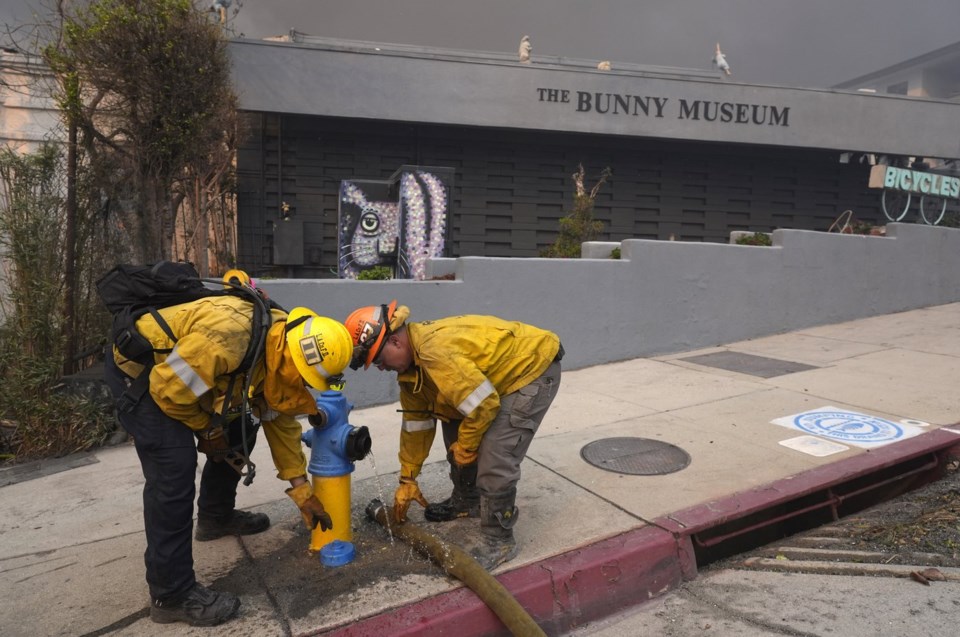For some 15 hours as wildfires spiraled out of control in Los Angeles, the public water system faced four times its usual demand, causing some hydrants to run dry and hindering the fight against the flames, local water officials said Wednesday.
The Los Angeles Department of Water and Power was pushing water from aqueducts and groundwater into the system, but demand was so high, it wasn’t enough to refill three one-million gallon tanks in hilly Pacific Palisades that help pressurize hydrants for the neighborhood. They went dry on several occasions and at least 1,000 buildings were engulfed in flames.
That prompted a swirl of criticism on social media against Los Angeles Mayor Karen Bass and Gov. Gavin Newsom's water management policies, including from President-elect Donald Trump. Regional water officials pushed back on Wednesday, saying the system was strained due to heavy stress on a municipal water system not designed for fighting such massive blazes.
“We’re fighting a wildfire with urban water systems, and that is really challenging,” said Janisse Quiñones, CEO of the Los Angeles Department of Water and Power.
Indeed, as wildfires become increasingly common in urban areas such as Boulder, Colorado and Lahaina, Hawaii, public water systems are often unable to meet the demand of fighting these large fires. Human-caused climate change is making it worse, experts say.
Trump seized on the moment to blame Newsom for the dry fire hydrants. In a post on his Truth Social media network Wednesday, he renewed criticisms of the state's approach to balancing the distribution of water to farms and cities with the need to protect endangered species including the Delta smelt. Trump has sided with farmers over environmentalists in a long-running dispute over California’s scarce water resources.
Leaving more water in rivers for endangered fish is one thing, and water availability in Los Angeles is another, said Peter Gleick, senior fellow at the Pacific Institute, a nonprofit that focuses on global water sustainability.
“Those fights have been going on for a long time and they have not affected in any way water supply for firefighting in southern California,” Gleick said.
About 40 percent of Los Angeles city water comes from state-controlled projects connected to northern California, and the state has limited water deliveries this year. Yet the southern California reservoirs these canals help feed are at above-average levels for this time of year.
Beyond water availability, large urban fires can also melt or otherwise damage pipes, causing them to leak large amounts of water, draining pressure from the system, said Andrew Whelton, an engineering professor at Purdue University. Individual homes with water meters that have a remote shutoff can help water utilities quickly stem such losses, Whelton said.
The 2023 fire that ripped through the historic town of Lahaina and claimed more than 100 lives burned so quickly in a dense area, that pipe bursts made it hard to maintain enough water pressure for fire fighting efforts.
In the 2021 Marshall Fire in Colorado, the city of Louisville's water department had workers manually open valves to let untreated water from the Colorado River and Boulder Creek into pipes to restore pressure. That helped firefighters but also led to water contamination.
LADWP is sending in mobile water tankers to help fight the fires, which can be refilled at hydrants that haven’t lost pressure, Quiñones said. It takes about 30 minutes to refill about 4,000 gallons of water.
Municipal water systems are not designed to fight wildfires, said Mark Pestrella, director of Los Angeles County Department of Public Works.
“That’s why air support is so critical to the firefight. And unfortunately, wind and air visibility have prevented that support,” Pestrella said. County and city reservoirs are ready to be used to fight fires from the air once it becomes safe to fly, he said.
Officials are urging residents across the region to conserve water so there’s enough for firefighters to use.
__
The Associated Press receives support from the Walton Family Foundation for coverage of water and environmental policy. The AP is solely responsible for all content. For all of AP’s environmental coverage, visit https://apnews.com/hub/climate-and-environment
Brittany Peterson, The Associated Press




